Publications
Total 101건
-
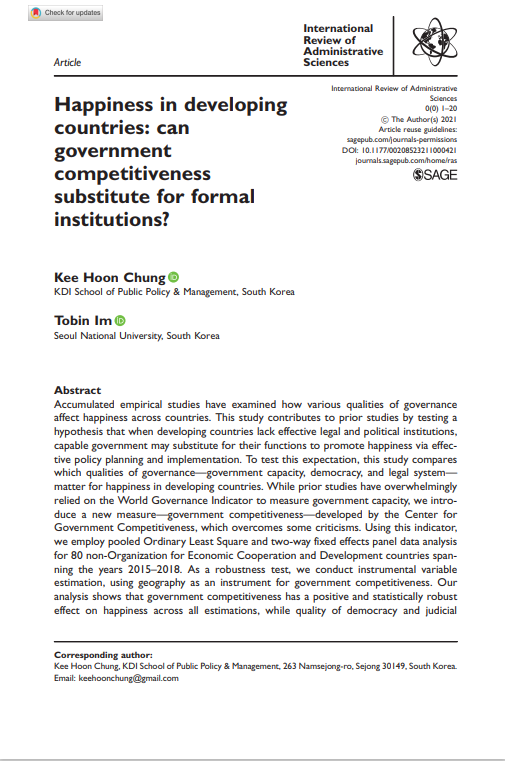 Chung, K. H. & Im. T. (2021) Happiness in developing countries: can government competitiveness substitute for formal institutions? International Review of Administrative Sciences. 0(0), 1-20
Chung, K. H. & Im. T. (2021) Happiness in developing countries: can government competitiveness substitute for formal institutions? International Review of Administrative Sciences. 0(0), 1-20Accumulated empirical studies have examined how various qualities of governance affect happiness across countries. This study contributes to prior studies by testing a hypothesis that when developing countries lack effective legal and political institutions, capable government may substitute for their functions to promote happiness via effecꠓtive policy planning and implementation. To test this expectation, this study compares which qualities of governance—government capacity, democracy, and legal system—matter for happiness in developing countries. While prior studies have overwhelmingly relied on the World Governance Indicator to measure government capacity, we introꠓduce a new measure—government competitiveness—developed by the Center for Government Competitiveness, which overcomes some criticisms. Using this indicator, we employ pooled Ordinary Least Square and two-way fixed effects panel data analysis for 80 non-Organization for Economic Cooperation and Development countries spanꠓning the years 2015–2018. As a robustness test, we conduct instrumental variable estimation, using geography as an instrument for government competitiveness. Our analysis shows that government competitiveness has a positive and statistically robust effect on happiness across all estimations, while quality of democracy and judicial independence display ambivalent effects. Our instrumental variable results suggest that judicial independence and quality of democracy display a substituting and complementꠓing relationship with government competitiveness, respectively.
2024-03-22
Read More -
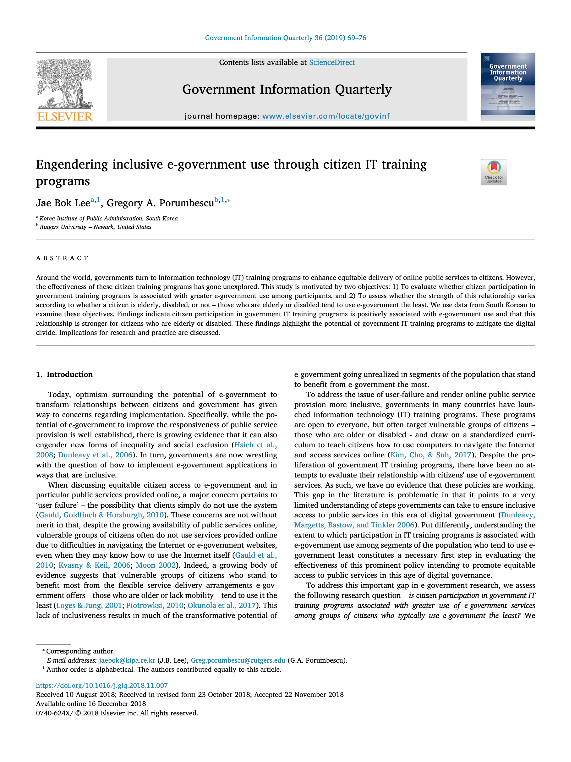 Lee,Jae Bok, Porumbescu,G.A. (2019) Engendering Inclusive E-Government Use Through Citizen IT Training Programs Government Information Quarterly. 36(1), 69-76
Lee,Jae Bok, Porumbescu,G.A. (2019) Engendering Inclusive E-Government Use Through Citizen IT Training Programs Government Information Quarterly. 36(1), 69-76Around the world, governments turn to IT training programs to enhance equitable delivery of online public services to citizens. However, the effectiveness of these citizen training programs has gone unexplored. This study is motivated by two objectives: 1) To evaluate whether citizen participation in government training programs is associated with greater e-government use among participants, and 2) To assess whether the strength of this relationship varies according to whether a citizen is elderly, disabled, or not – those who are elderly or disabled tend to use e-government the least. We use data from South Korean to examine these objectives. Findings indicate citizen participation in government IT training programs is positively associated with e-government use and that this relationship is stronger for citizens who are elderly or disabled. These findings highlight the potential of government IT training programs to mitigate the digital divide. Implications for research and practice are discussed.
2024-03-22
Read More -
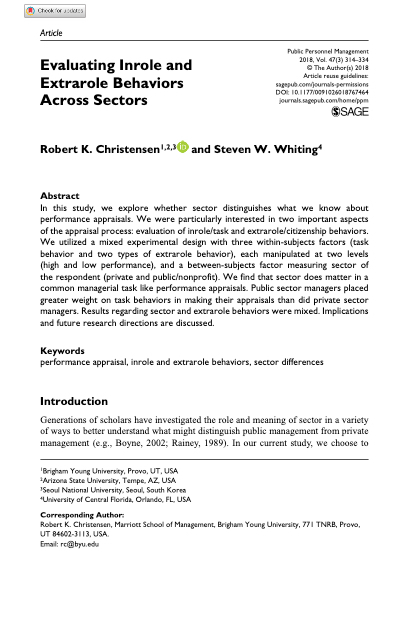 Christensen, R. K., & Whiting, S. W. (2018) Evaluating Inrole and Extrarole Behaviors Across Sectors. Public Personnel Management Public Personnel Management. 47(3), 314-334
Christensen, R. K., & Whiting, S. W. (2018) Evaluating Inrole and Extrarole Behaviors Across Sectors. Public Personnel Management Public Personnel Management. 47(3), 314-334In this study, we explore whether sector distinguishes what we know about performance appraisals. We were particularly interested in two important aspects of the appraisal process: evaluation of inrole/task and extrarole/citizenship behaviors. We utilized a mixed experimental design with three within-subjects factors (task behavior and two types of extrarole behavior), each manipulated at two levels (high and low performance), and a between-subjects factor measuring sector of the respondent (private and public/nonprofit). We find that sector does matter in a common managerial task like performance appraisals. Public sector managers placed greater weight on task behaviors in making their appraisals than did private sector managers. Results regarding sector and extrarole behaviors were mixed. Implications and future research directions are discussed.
2024-03-22
Read More -
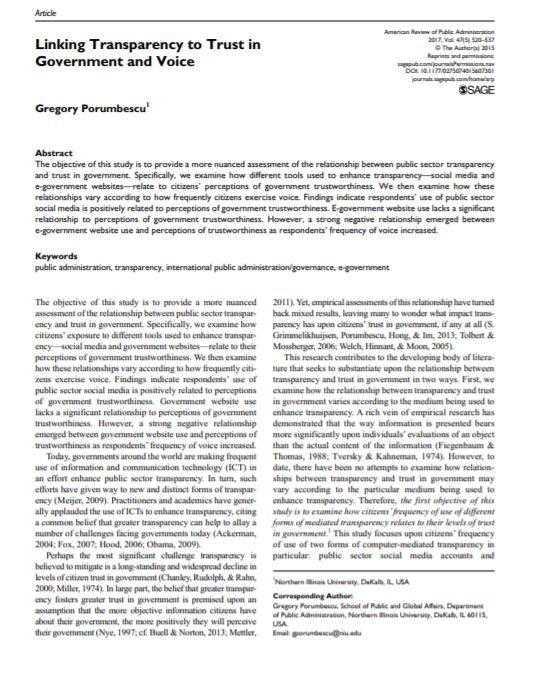 Porumbescu, G.A. (2017) Linking transparency to trust in government and voice The American Review of Public Administration. 47(5), 520-537
Porumbescu, G.A. (2017) Linking transparency to trust in government and voice The American Review of Public Administration. 47(5), 520-537Abstract The objective of this study is to provide a more nuanced assessment of the relationship between public sector transparency and trust in government. Specifically, we examine how different tools used to enhance transparency—social media and e-government websites—relate to citizens’ perceptions of government trustworthiness. We then examine how these relationships vary according to how frequently citizens exercise voice. Findings indicate respondents’ use of public sector social media is positively related to perceptions of government trustworthiness. E-government website use lacks a significant relationship to perceptions of government trustworthiness. However, a strong negative relationship emerged between e-government website use and perceptions of trustworthiness as respondents’ frequency of voice increased.
2024-03-22
Read More -
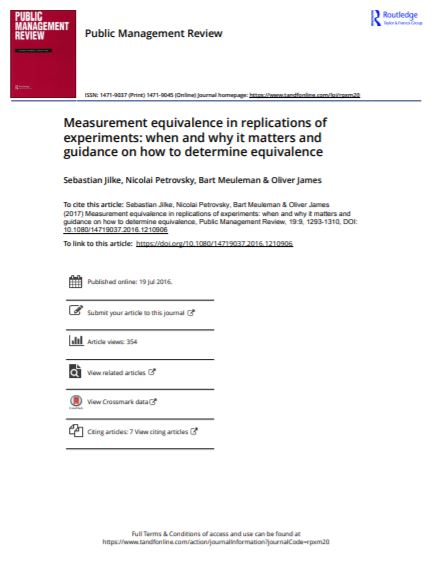 Jilke, S., Petrovsky, N., Meuleman, B., & James, O. (2017 ) Measurement equivalence in replications of experiments: when and why it matters and guidance on how to determine equivalence Public Management Review. 19(9), 1293-1310
Jilke, S., Petrovsky, N., Meuleman, B., & James, O. (2017 ) Measurement equivalence in replications of experiments: when and why it matters and guidance on how to determine equivalence Public Management Review. 19(9), 1293-1310[Abstract] Replications of experiments are typically conducted to verify initial findings, increase their external validity, or to study the boundary conditions of treatment effects. A crucial and implicitly made assumption is that outcome measures in experiments are sufficiently comparable (i.e., equivalent) across experimental settings. We argue that there are good reasons to believe that this equivalence assumption may not always be met and should therefore be tested empirically. Integrating the literature on experimental replication and survey measurement equivalence, we provide guidance when and how experimental replicators need to determine cross-replication equivalence.
2024-03-22
Read More -
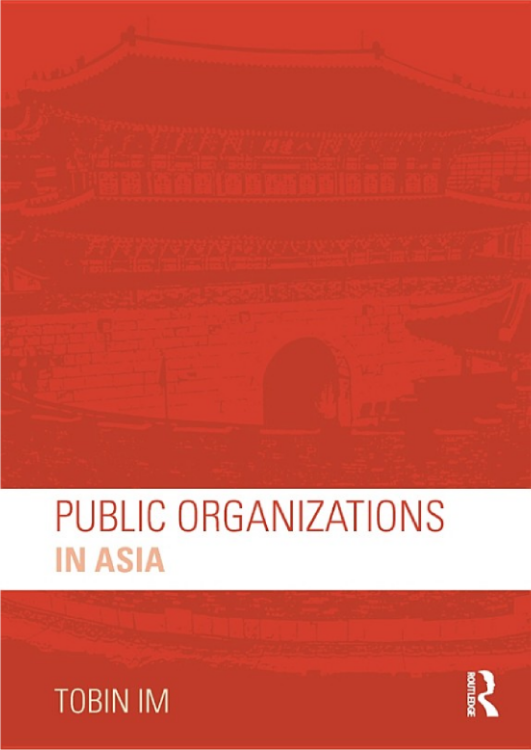 Tobin, Im. (2016) Public Organizations in Asia London:Routledge.
Tobin, Im. (2016) Public Organizations in Asia London:Routledge.Public Organizations in Asia introduces students to the fundamental theories of organizations and teaches them how to analyze different types of public organizations in East and Southeast Asia. Moving away from traditional Western theory and examples, this textbook provides numerous case studies of Asian organizations where different ideologies, administrative tradition, and social circumstances prevail. Key pedagogical features of Public Organizations in Asia include: - Learning objectives for each chapter - End of chapter discussion questions - Short student exercises - Concise case studies throughout the chapters Training students to be future leaders of Asian public organizations, this book is an essential text for undergraduate and graduate courses on public administration in Asia. It will also be a useful supplementary text for courses on comparative public administration.
2024-03-22
Read More -
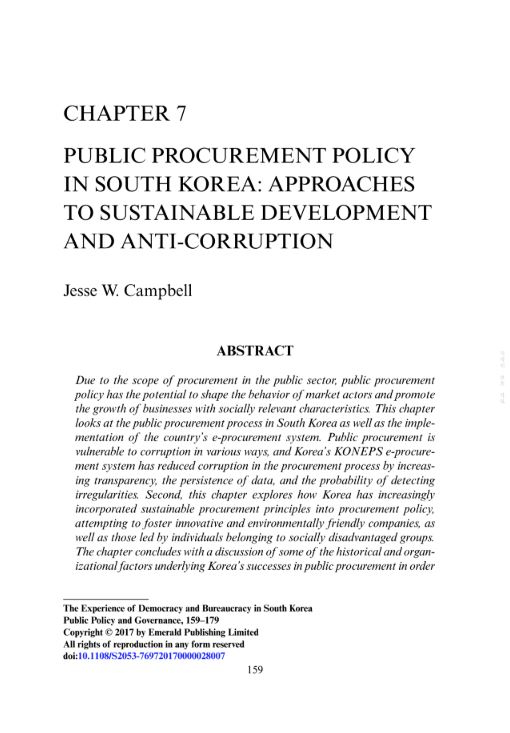 Campbell, J. W. (2017) Public Procurement Policy in South Korea: Approaches to Sustainable Development and Anti-Corruption. In The Experience of Democracy and Bureaucracy in South Korea Emerald Publishing Limited. 159-179
Campbell, J. W. (2017) Public Procurement Policy in South Korea: Approaches to Sustainable Development and Anti-Corruption. In The Experience of Democracy and Bureaucracy in South Korea Emerald Publishing Limited. 159-179Abstract Due to the scope of procurement in the public sector, public procurement policy has the potential to shape the behavior of market actors and promote the growth of businesses with socially relevant characteristics. This chapter looks at the public procurement process in South Korea as well as the implementation of the country’s e-procurement system. Public procurement is vulnerable to corruption in various ways, and Korea’s KONEPS e-procurement system has reduced corruption in the procurement process by increasing transparency, the persistence of data, and the probability of detecting irregularities. Second, this chapter explores how Korea has increasingly incorporated sustainable procurement principles into procurement policy, attempting to foster innovative and environmentally friendly companies, as well as those led by individuals belonging to socially disadvantaged groups. The chapter concludes with a discussion of some of the historical and organizational factors underlying Korea’s successes in public procurement in order to better understand the extent to which currently developing countries can draw upon the Korean case to improve their own procurement policies.
2024-03-22
Read More -
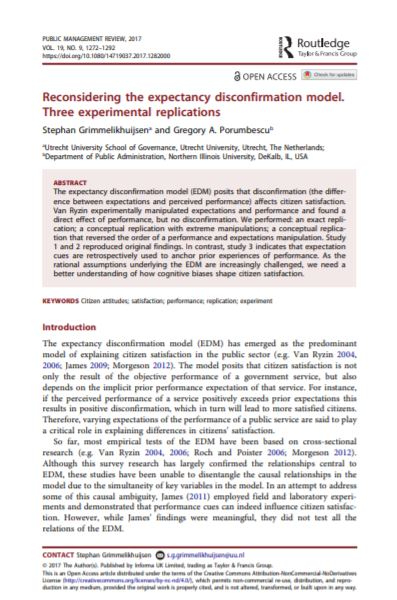 Grimmelikhuijsen, S., & Porumbescu, G. A. (2017) Reconsidering the expectancy disconfirmation model, Three experimental replications. Public Management Review. 19(9), 1272-1292
Grimmelikhuijsen, S., & Porumbescu, G. A. (2017) Reconsidering the expectancy disconfirmation model, Three experimental replications. Public Management Review. 19(9), 1272-1292[Abstract] The expectancy disconfirmation model (EDM) posits that disconfirmation (the difference between expectations and perceived performance) affects citizen satisfaction. Van Ryzin experimentally manipulated expectations and performance and found a direct effect of performance, but no disconfirmation. We performed: an exact replication; a conceptual replication with extreme manipulations; a conceptual replication that reversed the order of a performance and expectations manipulation. Study 1 and 2 reproduced original findings. In contrast, study 3 indicates that expectation cues are retrospectively used to anchor prior experiences of performance. As the rational assumptions underlying the EDM are increasingly challenged, we need a better understanding of how cognitive biases shape citizen satisfaction.
2024-03-22
Read More -
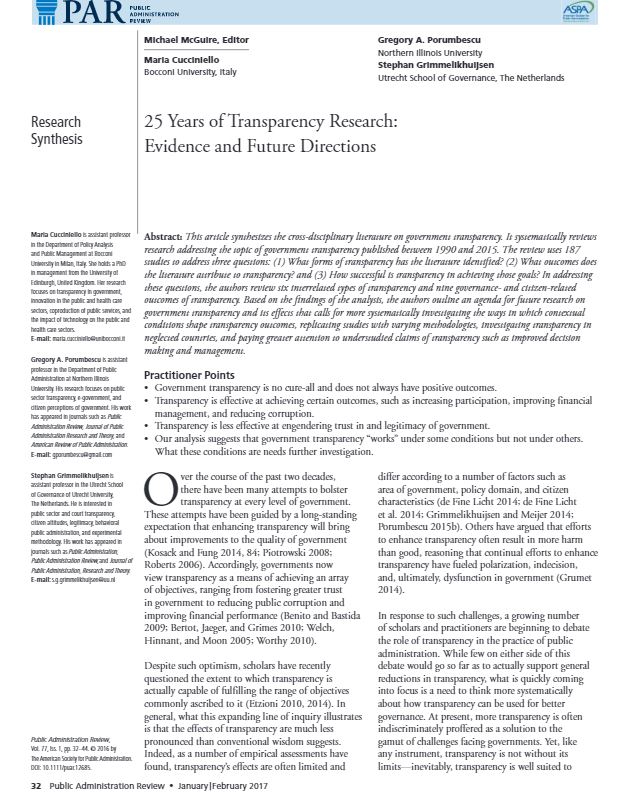 Cucciniello, M., Porumbescu, G. A., & Grimmelikhuijsen, S. (2017) 25 years of transparency research: evidence and future directions Public Administration Review,. 77(1), 32-44
Cucciniello, M., Porumbescu, G. A., & Grimmelikhuijsen, S. (2017) 25 years of transparency research: evidence and future directions Public Administration Review,. 77(1), 32-44Abstract This article synthesizes the cross-disciplinary literature on government transparency. It systematically reviews research addressing the topic of government transparency published between 1990 and 2015. The review used 187 studies to assess three questions: (1) what forms of transparency has the literature identified?; (2) what outcomes does the literature attribute to transparency?; and (3) how successful is transparency in achieving those goals? In addressing these questions, we reviewed six interrelated types of transparency and nine governance and citizen related outcomes of transparency. Based upon the findings of the analysis, we outline an agenda for future research on government transparency and its effects, which calls for: more systematically investigating the ways in which contextual conditions shapes transparency outcomes, replicating studies with varying methodologies, investigating transparency in neglected countries, and paying greater attention to understudied claims of transparency such as decision-making and management. Practitioner Points • Government transparency is no cure-all and does not always have positive outcomes. • Instead, transparency is effective in achieving certain outcomes, such as improving participation, financial management and reducing corruption. • Transparency is less effective at engendering trust and legitimacy of government. • Our analysis suggests government transparency ‘works’ under some conditions but not under others. What these conditions are needs further investigation.
2024-03-22
Read More -
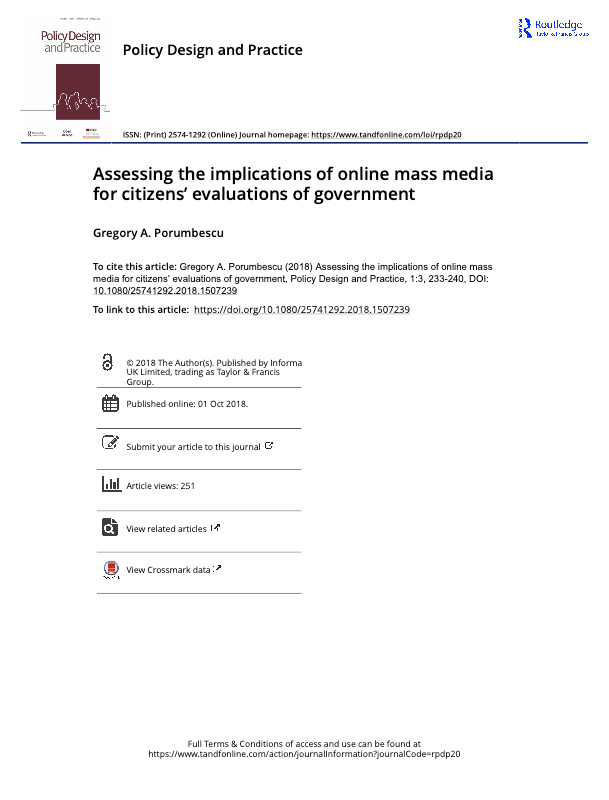 Gregory A.P. (2018) Assessing the implications of online mass media for citizens’ evaluations of government Policy Design and Practice. 1(3), 233-240
Gregory A.P. (2018) Assessing the implications of online mass media for citizens’ evaluations of government Policy Design and Practice. 1(3), 233-240When assessing the potential of information and communications technology (ICT) to improve relationships between citizens and their government, public management research tends to focus on government applications of ICT and neglects implications resulting from private actors use of ICT. Given the rapid growth in private online mass media outlets over the past decade, this negligence is problematic because it biases our understanding of the implications of ICTs for citizens’ relationship with government. This paper discusses how the proliferation of online mass media outlets may influence citizens’ evaluations of their government. In doing, two key points are distilled. First, as the number of mass media outlets increase online, citizens will tend to access information that reaffirms their expectations of government. Second, as citizens’ access a narrower range of content that reinforces their expectations of government, frequency of access may play a more pronounced role in explaining variation in citizens’ evaluations of government. The paper concludes with a discussion of implications.
2024-03-22
Read More -
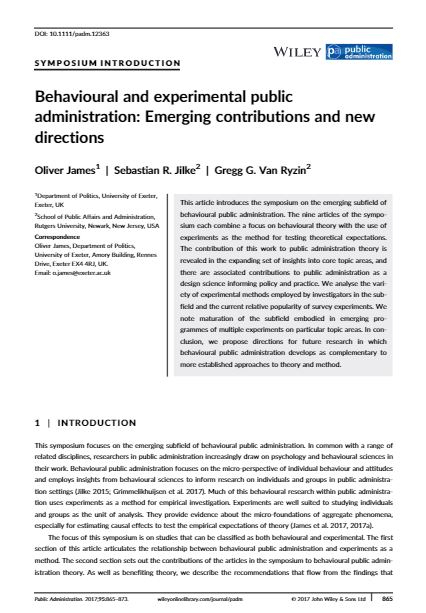 James, O., Jilke, S. R., & Van Ryzin, G. G. (2017 ) Behavioural and experimental public administration: Emerging contributions and new directions Public Administration. 95(4), 865-873
James, O., Jilke, S. R., & Van Ryzin, G. G. (2017 ) Behavioural and experimental public administration: Emerging contributions and new directions Public Administration. 95(4), 865-873Abstract This article introduces the symposium on the emerging subfield of behavioural public administration. The nine articles of the symposium each combine a focus on behavioural theory with the use of experiments as the method for testing theoretical expectations. The contribution of this work to public administration theory is revealed in the expanding set of insights into core topic areas, and there are associated contributions to public administration as a design science informing policy and practice. We analyse the variety of experimental methods employed by investigators in the subfield and the current relative popularity of survey experiments. We note maturation of the subfield embodied in emerging programmes of multiple experiments on particular topic areas. In conclusion, we propose directions for future research in which behavioural public administration develops as complementary to more established approaches to theory and method.
2024-03-22
Read More -
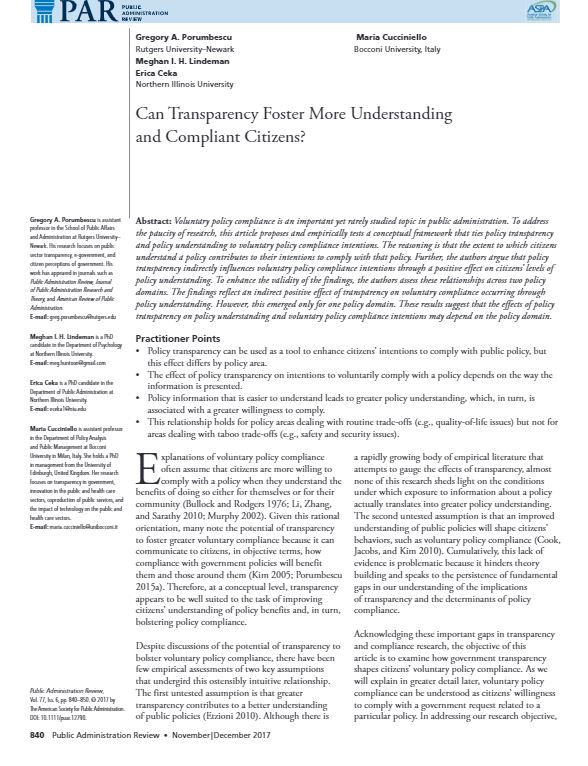 Porumbescu, G. A., Lindeman, M. I., Ceka, E., & Cucciniello, M. (2017) Can transparency foster more understanding and compliant citizens? Public Administration Review. 77(6), 840-850
Porumbescu, G. A., Lindeman, M. I., Ceka, E., & Cucciniello, M. (2017) Can transparency foster more understanding and compliant citizens? Public Administration Review. 77(6), 840-850Voluntary policy compliance is an important yet rarely studied topic in public administration. To address the paucity of research, this article proposes and empirically tests a conceptual framework that ties policy transparency and policy understanding to voluntary policy compliance intentions. The reasoning is that the extent to which citizens understand a policy contributes to their intentions to comply with that policy. Further, the authors argue that policy transparency indirectly influences voluntary policy compliance intentions through a positive effect on citizens’ levels of policy understanding. To enhance the validity of the findings, the authors assess these relationships across two policy domains. The findings reflect an indirect positive effect of transparency on voluntary compliance occurring through policy understanding. However, this emerged only for one policy domain. These results suggest that the effects of policy transparency on policy understanding and voluntary policy compliance intentions may depend on the policy domain.
2024-03-22
Read More -
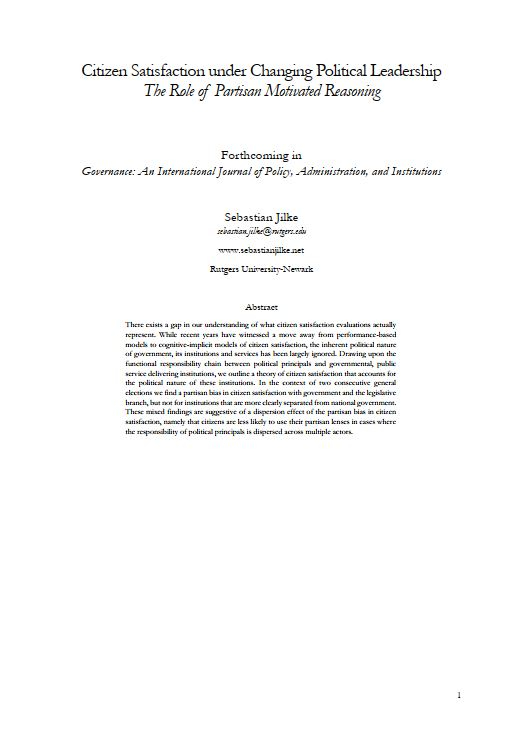 Jilke, S. (2018) Citizen satisfaction under changing political leadership: The role of partisan motivated reasoning Governance. 31(3), 515-533
Jilke, S. (2018) Citizen satisfaction under changing political leadership: The role of partisan motivated reasoning Governance. 31(3), 515-533Abstract There exists a gap in our understanding of what citizen satisfaction evaluations actually represent. While recent years have witnessed a move away from performance-based models to cognitive-implicit models of citizen satisfaction, the inherent political nature of government, its institutions and services has been largely ignored. Drawing upon the functional responsibility chain between political principals and governmental, public service delivering institutions, we outline a theory of citizen satisfaction that accounts for the political nature of these institutions. In the context of two consecutive general elections we find a partisan bias in citizen satisfaction with government and the legislative branch, but not for institutions that are more clearly separated from national government. These mixed findings are suggestive of a dispersion effect of the partisan bias in citizen satisfaction, namely that citizens are less likely to use their partisan lenses in cases where the responsibility of political principals is dispersed across multiple actors.
2024-03-22
Read More -
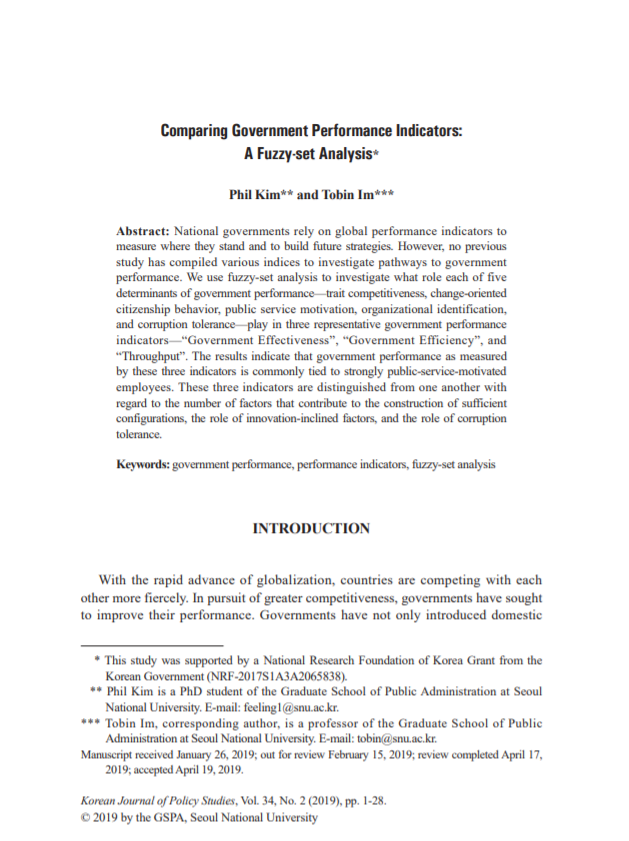 Phil, Kim. Tobin, Im. (2019) Comparing Government Performance Indicators: A Fuzzy-set analysis The Korean Journal of Policy Studies. 34(2)
Phil, Kim. Tobin, Im. (2019) Comparing Government Performance Indicators: A Fuzzy-set analysis The Korean Journal of Policy Studies. 34(2)National governments rely on global performance indicators to measure where they stand and to build future strategies. However, no previous study has compiled various indices to investigate pathways to government performance. We use fuzzy-set analysis to investigate what role each of five determinants of government performance—trait competitiveness, change-oriented citizenship behavior, public service motivation, organizational identification, and corruption tolerance—play in three representative government performance indicators—Government Effectiveness, Government Efficiency, and Throughput. The results indicate that government performance as measured by these three indicators is commonly tied to strongly public-service-motivated employees. These three indicators are distinguished from one another with regard to the number of factors that contribute to the construction of sufficient configurations, the role of innovation-inclined factors, and the role of corruption tolerance.
2024-03-22
Read More -
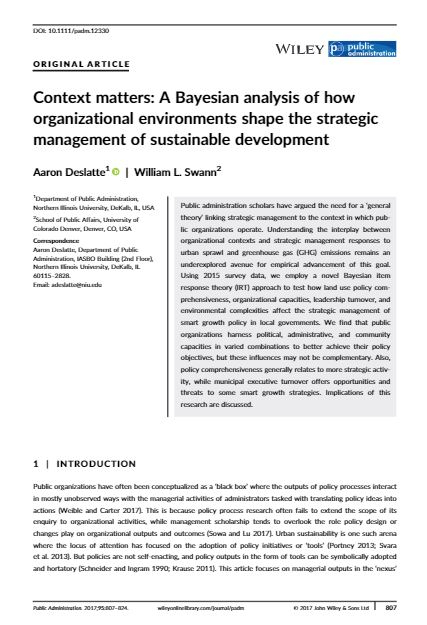 Deslatte, A., & Swann, W. L. (2017) Context matters: A Bayesian analysis of how organizational environments shape the strategic management of sustainable development Public Administration. 95(3), 807-824
Deslatte, A., & Swann, W. L. (2017) Context matters: A Bayesian analysis of how organizational environments shape the strategic management of sustainable development Public Administration. 95(3), 807-824Abstract Public administration scholars have argued the need for a ‘general theory’ linking strategic management to the context in which public organizations operate. Understanding the interplay between organizational contexts and strategic management responses to urban sprawl and greenhouse gas (GHG) emissions remains an underexplored avenue for empirical advancement of this goal. Using 2015 survey data, we employ a novel Bayesian item response theory (IRT) approach to test how land use policy comprehensiveness, organizational capacities, leadership turnover, and environmental complexities affect the strategic management of smart growth policy in local governments. We find that public organizations harness political, administrative, and community capacities in varied combinations to better achieve their policy objectives, but these influences may not be complementary. Also, policy comprehensiveness generally relates to more strategic activity, while municipal executive turnover offers opportunities and threats to some smart growth strategies. Implications of this research are discussed.
2024-03-22
Read More -
 Oh, Namkyung. (2017) Dimensions of strategic intervention for risk reduction and mitigation: a case study of the MV Sewol incident Journal of Risk Research. 20(12), 1516-1533
Oh, Namkyung. (2017) Dimensions of strategic intervention for risk reduction and mitigation: a case study of the MV Sewol incident Journal of Risk Research. 20(12), 1516-1533Organizations in disaster management system should learn from previous experience and strategically use their lesson for the refinement of a system’s competencies for risk management. However, the MV Sewol incident revealed the absence of the organizational learning in the Korean disaster management system. With mixed methods of content analysis, in-depth interview, and social network analysis, this study identified key failure factors in response to the incident and categorized them by managerial, structural, and institutional domains. While the Korean government took bold steps to rebuild its risk management system, those efforts were biased to structural reforms and lacked fundamental changes in human and informational resources management. Based on the findings, this study suggests the balanced efforts for system refinement for effective risk management.
2024-03-22
Read More -
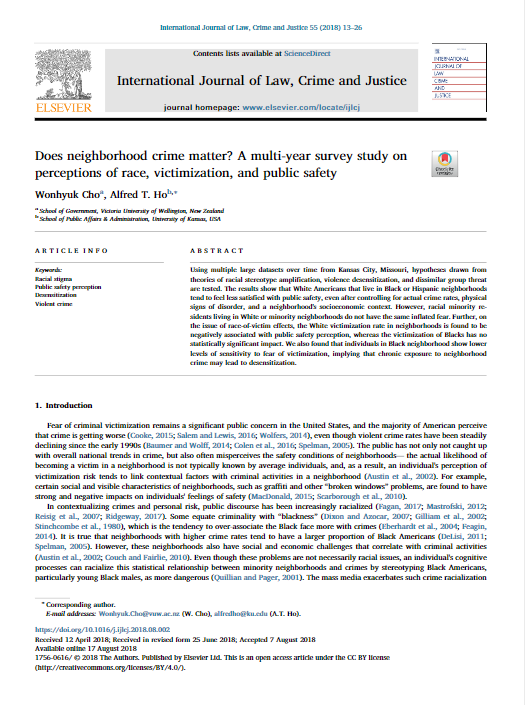 Cho, Wonhyuk, Ho, Alfred T. (2018) Does neighborhood crime matter? A multi-year survey study on perceptions of race, victimization, and public safety International Journal of Law Crime and Justice . 55,13-26
Cho, Wonhyuk, Ho, Alfred T. (2018) Does neighborhood crime matter? A multi-year survey study on perceptions of race, victimization, and public safety International Journal of Law Crime and Justice . 55,13-26Using multiple large datasets over time from Kansas City, Missouri, hypotheses drawn from theories of racial stereotype amplification, violence desensitization, and dissimilar group threat are tested. The results show that White Americans that live in Black or Hispanic neighborhoods tend to feel less satisfied with public safety, even after controlling for actual crime rates, physical signs of disorder, and a neighborhood's socioeconomic context. However, racial minority residents living in White or minority neighborhoods do not have the same inflated fear. Further, on the issue of race-of-victim effects, the White victimization rate in neighborhoods is found to be negatively associated with public safety perception, whereas the victimization of Blacks has no statistically significant impact. We also found that individuals in Black neighborhood show lower levels of sensitivity to fear of victimization, implying that chronic exposure to neighborhood crime may lead to desensitization.
2024-03-22
Read More -
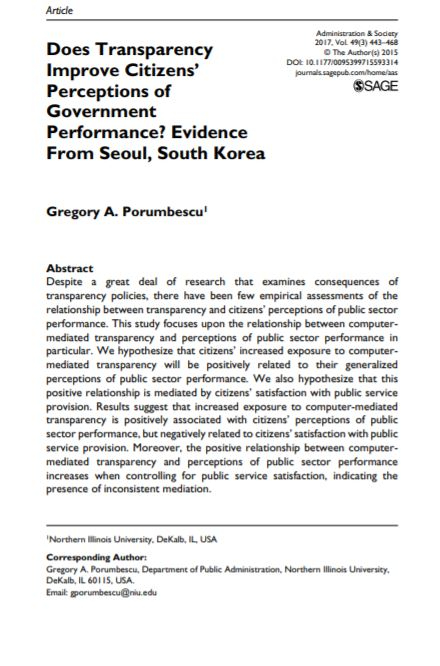 Porumbescu, G. A. (2017) Does transparency improve citizens’ perceptions of government performance? Evidence from Seoul, South Kore Administration & Society. 49(3), 443-468
Porumbescu, G. A. (2017) Does transparency improve citizens’ perceptions of government performance? Evidence from Seoul, South Kore Administration & Society. 49(3), 443-468Abstract Despite a great deal of research that examines consequences of transparency policies, there have been few empirical assessments of the relationship between transparency and citizens’ perceptions of public sector performance. This study focuses upon the relationship between computer-mediated transparency and perceptions of public sector performance in particular. We hypothesize that citizens’ increased exposure to computer-mediated transparency will be positively related to their generalized perceptions of public sector performance. We also hypothesize that this positive relationship is mediated by citizens’ satisfaction with public service provision. Results suggest that increased exposure to computer-mediated transparency is positively associated with citizens’ perceptions of public sector performance, but negatively related to citizens’ satisfaction with public service provision. Moreover, the positive relationship between computer-mediated transparency and perceptions of public sector performance increases when controlling for public service satisfaction, indicating the presence of inconsistent mediation.
2024-03-22
Read More -
 Jesse W. Campbell. (2018) Efficiency, Incentives, and Transformational Leadership: Understanding Collaboration Preferences in the Public Sector Public Performance & Management Review. 41(2), 277-299
Jesse W. Campbell. (2018) Efficiency, Incentives, and Transformational Leadership: Understanding Collaboration Preferences in the Public Sector Public Performance & Management Review. 41(2), 277-299In the public sector, participant attitudes are an important determinant of the success of inter-organizational collaboration initiatives. In this study, a model of employee willingness to collaborate is proposed in which the influence of transformational leadership is determined in part by the performance orientation of the organizational context in which it is enacted. The theoretical model is tested empirically using survey data collected from public employees in South Korea and regression-based Monte Carlo simulation. The analysis suggests that the effect of transformational leadership is amplified by an organization’s emphasis on internal efficiency and its use of performance-based incentives, factors that themselves have independent positive and negative effects, respectively, on attitudes about collaboration. This study links transformational leadership to an increasingly necessary process in the public sector and highlights its context-dependent influence. Implications of the findings are discussed, including the notion that the efficacy of tactics adopted to support inter-organizational collaboration may be a function of their consistency with the realities of established organizational policies and processes.
2024-03-22
Read More -
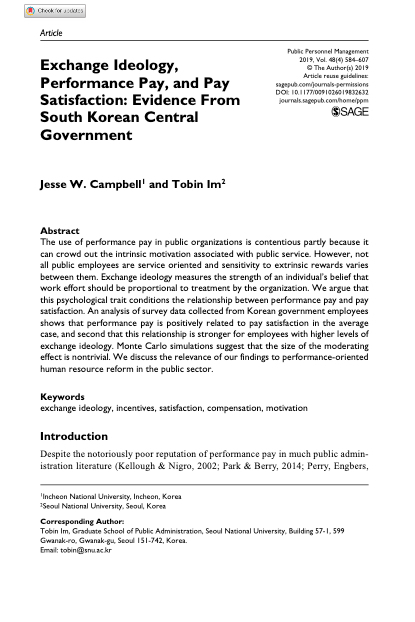 Campbell, J. W., & Im, T. (2019) Exchange Ideology, Performance Pay, and Pay Satisfaction: Evidence From South Korean Central Government Public Personnel Management. 48(4), 584–607
Campbell, J. W., & Im, T. (2019) Exchange Ideology, Performance Pay, and Pay Satisfaction: Evidence From South Korean Central Government Public Personnel Management. 48(4), 584–607The use of performance pay in public organizations is contentious partly because it can crowd out the intrinsic motivation associated with public service. However, not all public employees are service oriented and sensitivity to extrinsic rewards varies between them. Exchange ideology measures the strength of an individual’s belief that work effort should be proportional to treatment by the organization. We argue that this psychological trait conditions the relationship between performance pay and pay satisfaction. An analysis of survey data collected from Korean government employees shows that performance pay is positively related to pay satisfaction in the average case, and second that this relationship is stronger for employees with higher levels of exchange ideology. Monte Carlo simulations suggest that the size of the moderating effect is nontrivial. We discuss the relevance of our findings to performance-oriented human resource reform in the public sector.
2024-03-22
Read More

